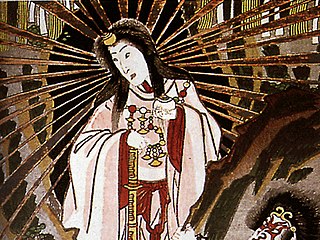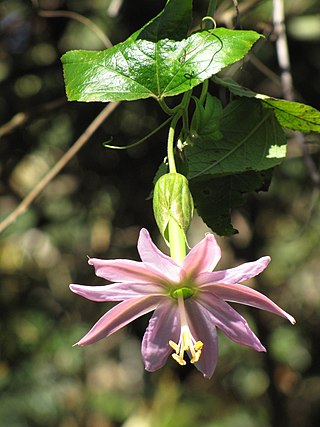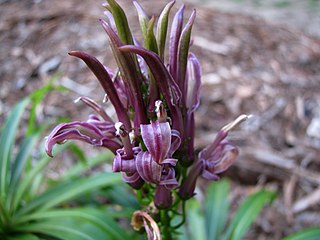External links
- Zimmerman, Elwood C. (1958). Insects of Hawaii. Vol. 8 Lepidoptera: Pyraloidea. University of Hawaii Press. hdl:10125/7337.
| Unadilla bidensana | |
|---|---|
| Scientific classification | |
| Kingdom: | |
| Phylum: | |
| Class: | |
| Order: | |
| Family: | |
| Genus: | |
| Species: | U. bidensana |
| Binomial name | |
| Unadilla bidensana (Swezey, 1933) | |
| Synonyms | |
| |
Unadilla bidensana is a moth of the family Pyralidae described by Otto Herman Swezey in 1933. It is endemic to the Hawaiian island of Kauai.
The larvae feed on Bidens cosmoides . They bore in the stems of their host plant. The infested stems become swollen and gall-like. Pupation takes place within this swelling.

Hawaii is an island state of the United States, in the Pacific Ocean about 2,000 miles (3,200 km) southwest of the U.S. mainland. It is the only state not on the North American mainland, the only state that is an archipelago, and the only state in the tropics.

The pineapple is a tropical plant with an edible fruit; it is the most economically significant plant in the family Bromeliaceae.

The papaya, papaw, or pawpaw is the plant species Carica papaya, one of the 21 accepted species in the genus Carica of the family Caricaceae. It was first domesticated in Mesoamerica, within modern-day southern Mexico and Central America. It is grown in several countries in regions with a tropical climate. In 2020, India produced 42% of the world's supply of papayas.

The tree ferns are arborescent (tree-like) ferns that grow with a trunk elevating the fronds above ground level, making them trees. Many extant tree ferns are members of the order Cyatheales, to which belong the families Cyatheaceae, Dicksoniaceae, Metaxyaceae, and Cibotiaceae. It is estimated that Cyatheales originated in the early Jurassic, and is the third group of ferns known to have given rise to tree-like forms. The others are the extinct Tempskya of uncertain position, and Osmundales where the extinct Guaireaceae and some members of Osmundaceae also grew into trees. In addition there were the Psaroniaceae and Tietea in the Marattiales, which is the sister group to most living ferns including Cyatheales.
Haole is a Hawaiian term for individuals who are not Native Hawaiian, and is applied to people primarily of European ancestry.

The nose flute is a musical instrument often played in Polynesia and the Pacific Rim countries. Other versions are found in Africa.

A lei is a garland or wreath common in Hawaii, across Polynesia, and the Philippines. More loosely defined, a lei is any series of objects strung together with the intent to be worn. Lei of various styles are given as gifts to honour people throughout the Pacific, being presented, for example, to visiting dignitaries, graduates, or to loved ones who are departing.

Taro is a root vegetable. It is the most widely cultivated species of several plants in the family Araceae that are used as vegetables for their corms, leaves, stems and petioles. Taro corms are a food staple in African, Oceanic, East Asian, Southeast Asian and South Asian cultures. Taro is believed to be one of the earliest cultivated plants.

Obake (お化け) and bakemono (化け物) are a class of yōkai, preternatural creatures in Japanese folklore. Literally, the terms mean a thing that changes, referring to a state of transformation or shapeshifting.

Passiflora tarminiana is a species of passionfruit. The yellow fruits are edible and their resemblance to small, straight bananas has given it the name banana passionfruit in some countries. It is native to the uplands of tropical South America and is now cultivated in many countries. In Hawaii and New Zealand it is now considered an invasive species. It was given the name banana passionfruit in New Zealand, where passionfruit are also prevalent. In Hawaii, it is called banana poka. In its Latin American homeland, it is known as curuba, curuba de Castilla, or curuba sabanera blanca (Colombia); taxo, tacso, tagso, tauso (Ecuador); parcha, taxo (Venezuela), tumbo or curuba (Bolivia); tacso, tumbo, tumbo del norte, trompos, tintin, porocsho or purpur (Peru).

The Hawaiian lobelioids are a group of flowering plants in the bellflower family, Campanulaceae, subfamily Lobelioideae, all of which are endemic to the Hawaiian Islands. This is the largest plant radiation in the Hawaiian Islands, and indeed the largest on any island archipelago, with over 125 species. The six genera involved can be broadly separated based on growth habit: Clermontia are typically branched shrubs or small trees, up to 7 metres (23 ft) tall, with fleshy fruits; Cyanea and Delissea are typically unbranched or branching only at the base, with a cluster of relatively broad leaves at the apex and fleshy fruits; Lobelia and Trematolobelia have long thin leaves down a single, non-woody stem and capsular fruits with wind-dispersed seeds; and the peculiar Brighamia have a short, thick stem with a dense cluster of broad leaves, elongate white flowers, and capsular fruits. The relationships among the genera and sections remains unsettled as of April 2022.

The Momphidae, or mompha moths, is a family of moths with some 115 described species. It was described by Gottlieb August Wilhelm Herrich-Schäffer in 1857. These moths tend to be rather small with a wingspan of up to 21 mm. The wings are held folded over the body at rest. The larvae are concealed feeders, either as leaf miners or within seeds or stems.
The Gtaʼ language, also known as Gta Asa, Didei or Didayi, is an Austroasiatic language spoken by the Didayi people of southernmost Odisha in India.

Schoenoplectus tabernaemontani is a species of flowering plant in the sedge family known by the common names softstem bulrush, grey club-rush, and great bulrush. It can be found throughout much of the world; it has been reported from every state in the United States, and from every province and territory in Canada except Nunavut. It grows in moist and wet habitat, and sometimes in shallow water.

Hellula undalis, the cabbage webworm or Old World webworm, is a moth of the family Crambidae. It is a widespread species which is found from Europe across Asia to the Pacific. It was first described from Italy.

Chilo suppressalis, the Asiatic rice borer or striped rice stemborer, is a moth of the family Crambidae. It is a widespread species, known from Iran, India, Sri Lanka, China, eastern Asia, Japan, Taiwan, Malaysia to the Pacific.

Kihei Charter School is a public charter school located in Kihei, Maui, Hawaii. Founded in 2001, Kihei Charter has been the only high school in Kihei, though Kihei High School, a long-delayed Hawaii Department of Education school, is under construction. Kihei Charter operates three different schools at one location, serving children from kindergarten through 12th grade. Kihei Charter advertises the use of project-based learning pedagogy and a focus on STEM education.

Donald Tai Loy Ho was a Hawaiian traditional pop musician, singer and entertainer. He is best known for the song "Tiny Bubbles" from the album of the same name.

Brittany Lehua Kamai is an American astrophysicist and racial justice activist. Kamai is a postdoctoral fellow at the University of California, Santa Cruz and the California Institute of Technology. She was the founder of #ShutDownSTEM, part of the Strike for Black Lives held on June 10, 2020. A native Hawaiian, Kamai grew up in Honolulu and graduated from President Theodore Roosevelt High School and the University of Hawaiʻi at Mānoa. She completed her Master of Arts from Fisk University and her PhD from Vanderbilt University. Kamai is only the second native Hawaiian to earn a doctorate in astrophysics and the third to earn a PhD in physics.
Jayden de Laura is an American football quarterback who most recently played for the Arizona Wildcats. He previously played at Washington State before transferring to Arizona in 2022.